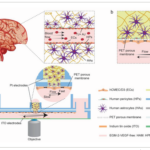2023-01-17 スウェーデン王国・王立工科大学(KTH)
◆その結果、胸部X線位相差撮影により、2mm以下の極小の気道とその疾患に関連した閉塞を可視化できることが報告されました。研究成果は、米国科学アカデミー紀要(PNAS)に報告されました。
◆この研究で使用された位相コントラスト法は、従来のX線画像では見えなかった微妙な病理学的変化を映し出すことができ、喘息や慢性閉塞性肺疾患(COPD)などの病気のスクリーニングに重要であると述べています。
◆従来のX線撮影では、X線ビームは体内を通過する際に、組織によって吸収される量が異なります。一方、検出器では、体内を通過した後のX線の強度(残量)を測定する。この過程が減衰と呼ばれ、X線画像を有用なものにするコントラストを与える基本的なメカニズムです。
◆位相差撮影は、1本のX線からより多くの情報を得るための方法です。それは、試料を通過するX線の波形の違いを測定することができるからです。X線は原子などの構造物と出会うことで、基準波に対して任意の位置(位相)を変化させることができます。この位相情報を使って、試料の構造を強調する画像を生成する。人間の胸部では、気管支の壁や小さな気道の境界を、より高いコントラストと解像度で強調することができる。
<関連情報>
- https://www.kth.se/en/om/nyheter/centrala-nyheter/advanced-imaging-tech-could-be-used-to-detect-early-stage-lung-disease-1.1230778
- https://www.pnas.org/doi/10.1073/pnas.2210214120
位相差仮想胸部X線撮影 Phase-contrast virtual chest radiography
Ilian Häggmark,Kian Shaker,Sven Nyrén,Bariq Al-Amiry,Ehsan Abadi,William P. Segars,Ehsan Samei,Hans M. Hertz
Proceedings of the National Academy of Sciences Published:December 29, 2022
DOI:https://doi.org/10.1073/pnas.2210214120

Significance
Chest radiography plays an important role in respiratory disease detection, yet the way it is used today is fundamentally limited by the underlying contrast mechanism: X-ray attenuation. This renders subtle pathological changes in the lungs invisible in conventional chest radiography as these do not sufficiently change the overall attenuation through the thorax. The last decades have seen tremendous progress in utilizing the phase shift of X-ray radiation to improve imaging sensitivity. However, human chest imaging with phase contrast remains largely unexplored. In our work, we generate realistic virtual chest radiographs to show that phase-contrast chest radiography can visualize the smallest airways and their disease-related obstruction, which cannot be observed today using the conventional technique.
Abstract
Respiratory X-ray imaging enhanced by phase contrast has shown improved airway visualization in animal models. Limitations in current X-ray technology have nevertheless hindered clinical translation, leaving the potential clinical impact an open question. Here, we explore phase-contrast chest radiography in a realistic in silico framework. Specifically, we use preprocessed virtual patients to generate in silico chest radiographs by Fresnel-diffraction simulations of X-ray wave propagation. Following a reader study conducted with clinical radiologists, we predict that phase-contrast edge enhancement will have a negligible impact on improving solitary pulmonary nodule detection (6 to 20 mm). However, edge enhancement of bronchial walls visualizes small airways (< 2 mm), which are invisible in conventional radiography. Our results show that phase-contrast chest radiography could play a future role in observing small-airway obstruction (e.g., relevant for asthma or early-stage chronic obstructive pulmonary disease), which cannot be directly visualized using current clinical methods, thereby motivating the experimental development needed for clinical translation. Finally, we discuss quantitative requirements on distances and X-ray source/detector specifications for clinical implementation of phase-contrast chest radiography.


